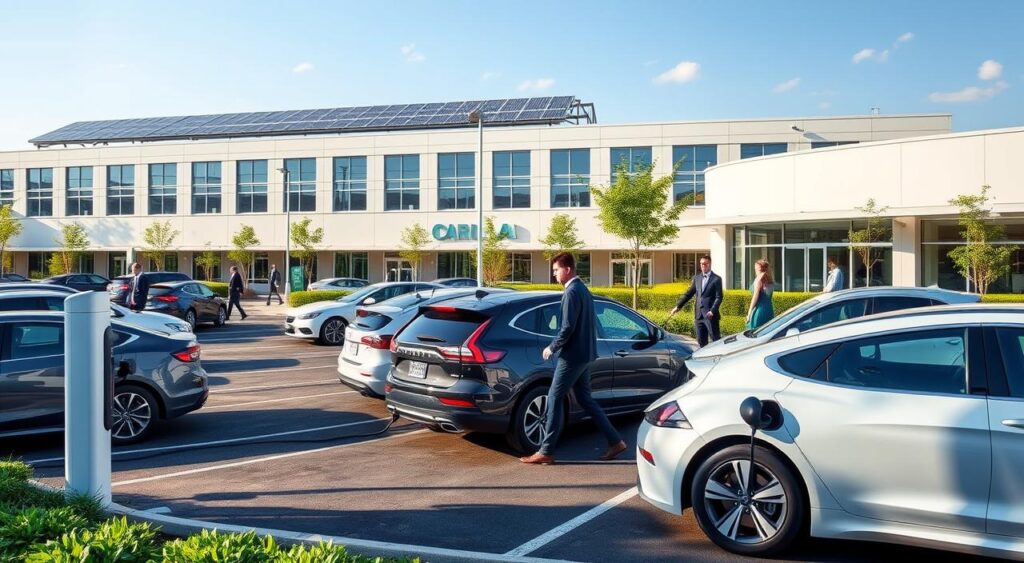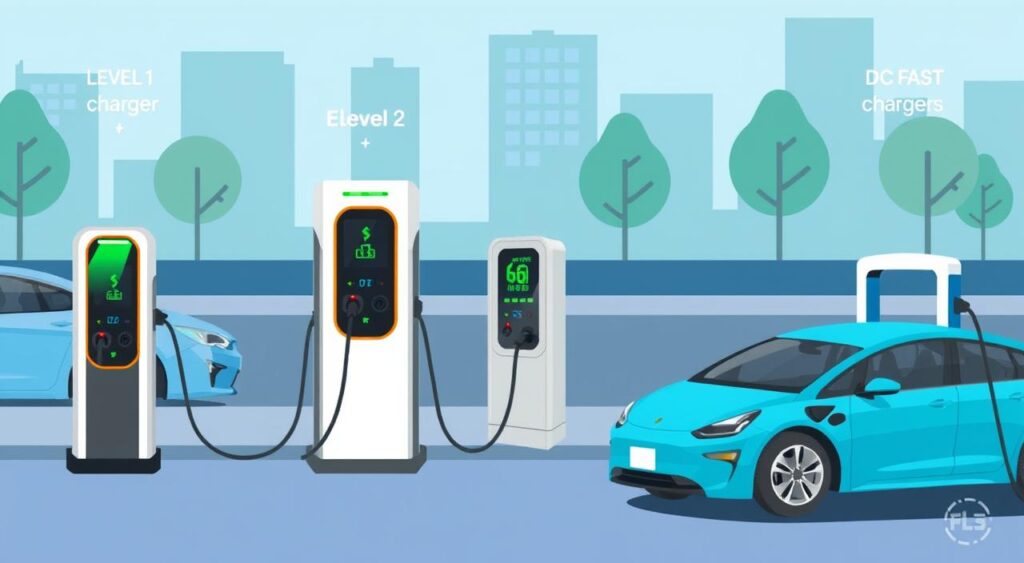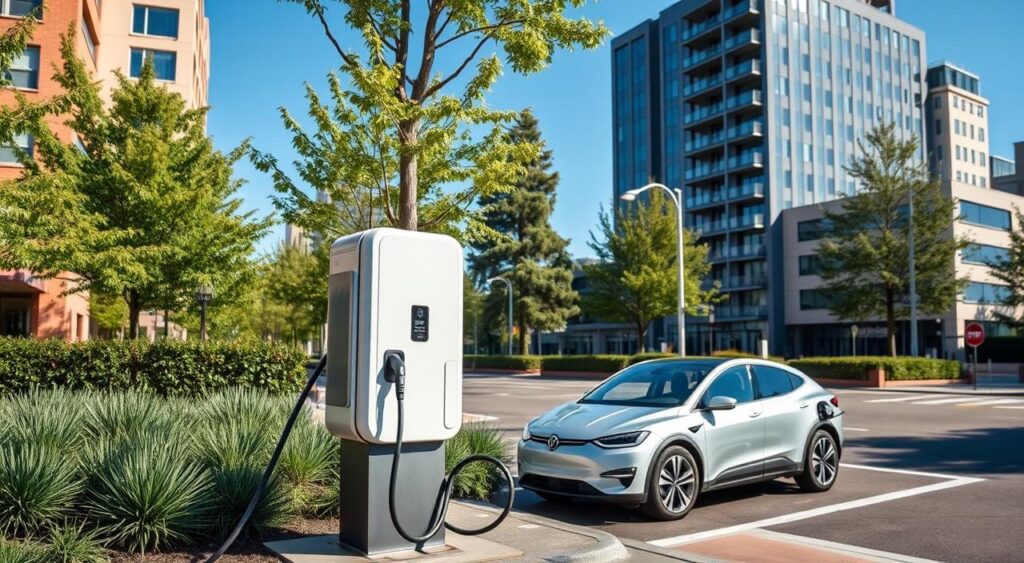Electric vehicles (EVs) are getting more popular as people look for green and affordable ways to travel. But, figuring out how to charge them can be tricky for newcomers. This guide will help you understand EV chargers and how to charge your electric vehicle well.
Key Takeaways
- Electric vehicles produce zero local emissions, contributing to a cleaner environment.
- Charging an electric vehicle costs approximately 35% less than filling up a gasoline car.
- EVgo powers all chargers with 100% renewable electricity from wind and solar.
- DC fast charging allows vehicles to typically charge in 15-45 minutes.
- Home charging is the most popular and convenient way to charge your electric vehicle.
What is an Electric Vehicle?
Electric vehicles (EVs) are changing how we travel. They are a clean and efficient choice compared to gas cars. EVs use electric motors and batteries, not gas, which cuts down on emissions.
Types of Electric Vehicles
There are three main types of electric vehicles: Battery Electric Vehicles (BEVs), Hybrid Electric Vehicles (HEVs), and Plug-in Hybrid Electric Vehicles (PHEVs). BEVs run only on batteries. HEVs and PHEVs have both a gas engine and an electric motor.
Benefits of Electric Vehicles
Electric vehicles have many benefits. They make no local emissions, which is good for the air and the planet. Also, charging an EV is often cheaper than filling up a gas car. As more renewable energy is used, EVs will get even better for the environment.
“The forecast anticipates 350 million EVs to be in operation by 2030, with a projection of 60% total EV share expected in the same year.”
EVs are becoming more popular fast. By 2022, 26 million EVs were reported. By 2030, 350 million EVs are expected, with 60% of the market then.
Understanding EV Charging Levels
The electric vehicle (EV) market is growing fast. Knowing about the different charging levels is key for EV owners. The level you choose depends on your driving habits, the EV you have, and local charging options. Let’s look at the three main levels: level 1 charging, level 2 charging, and level 3 (DC fast) charging.
Level 1 Charging
Level 1 charging is the slowest way to charge your EV. It uses a 120V household outlet, like the one for your appliances. This method gives 4-5 miles of range per hour. It’s good for overnight charging but not for quick charges or long trips.
Level 2 Charging
Level 2 charging is common, found in public stations and homes. It uses a 240V power source, like for big appliances. Level 2 chargers can give 25-75 miles of range per hour. This makes it a favorite for home and work charging.
Level 3 (DC Fast) Charging
Level 3 or DC fast charging is the fastest. These chargers give direct current (DC) power to the battery. They can add 150-250 miles of range in 15-45 minutes. They’re perfect for long trips or quick charges.
It’s important for EV owners to know about the different charging levels. This knowledge helps you decide on charging at home, work, or on the go. Understanding each level’s benefits and drawbacks optimizes your EV driving experience.
Charging Your EV at Home
Charging your electric vehicle (EV) at home is easy and saves money. With home charging, just plug in your EV when you get home. It will be ready to go in the morning, without needing to find a public charging station.
Home charging is also cheaper than public chargers. You only pay your usual electricity rate, without extra fees.
Benefits of Home Charging
The benefits of home charging for your EV include:
- Convenience: No need to plan trips to public charging stations, as you can charge your vehicle overnight at home.
- Cost savings: Charging at home is generally cheaper than using public charging stations.
- Consistent charging schedule: You can establish a regular charging routine and ensure your EV is ready to go every morning.
Installing a Home EV Charger
To enjoy the benefits of home charging, you need a dedicated EV charger, usually a Level 2 unit. You might need to upgrade your home’s electrical system for a Level 2 charger. Many places offer incentives and rebates to help with the cost of installing a home EV charger.
| EV Size | 7.4 kW Charger | 22 kW Charger |
|---|---|---|
| Small | 3 hours 45 minutes | 1 hour |
| Medium | 7 hours 45 minutes | 3 hours |
| Large | 10 hours | 4 hours 30 minutes |
The table shows how long it takes to charge a battery from 20 percent to 80 percent for different EV sizes. It uses a 7.4 kW or 22 kW home EV charger.
Charging Your EV at Work
Charging your electric vehicle at work is easy and handy. Over 34% of EV drivers use charging stations at work. Many companies offer employer-provided charging as a perk. This lets you charge your car while you’re at work.
Workplace charging is great for topping up your battery. It’s perfect if you can’t charge at home.
Employers must think about the costs of office charging. This includes the cost of equipment, installation, upkeep, and electricity. Luckily, there are incentives from the federal, state, and utility levels to help with these costs. Employers should pick the best charging option for their workplace based on their goals and needs.
- Level 1 charging stations are cheaper but charge vehicles at a slower rate, suitable for one vehicle per day.
- Level 2 stations are the most commonly used at workplaces and allow more than one vehicle to be charged per day.
- DC fast charging stations can be the most expensive to install but are useful for alleviating charging congestion or allowing employees to charge quickly.
When setting up workplace charging, employers need clear rules for use, registration, liability, sharing, and pricing. They should also have safety and management policies for Level 1 charging stations.
“Charging your EV at work can be a game-changer, if you don’t have a home charger. It’s a convenient way to top up your battery during the day.”
In the end, workplace charging is a great perk for employees and a smart choice for employers. It supports the growing use of electric vehicles.

Public Charging Stations
Public charging stations are great for longer trips or quick top-ups. Networks like EVgo, Electrify America, and ChargePoint offer thousands of stations across the U.S.
The number of public charging spots is growing fast. ChargePoint works with over 5,000 brands, including big names. They’ve helped power 11.4 billion electric miles and cut down on 2.5 million metric tons of emissions.
Finding Public Charging Stations
Finding public charging spots is now easy with online tools and apps. Use charging locator apps like PlugShare or ChargeHub to find stations near you. These apps show real-time info on availability and prices.
EVgo is a big name in public charging, with over 1 million users and 1,000 stations. They’ve teamed up with GM and Pilot to grow their network. This makes it easier for EV drivers to find charging spots on the go.
“The Department of Energy has provided a $1.05 billion loan guarantee to EVgo to expand its charging network, highlighting government support for the growth of electric vehicle infrastructure.”
With more public charging stations and easy-to-use tools, EV owners can take longer trips. They know they can find a place to recharge their vehicle easily.
EV Charger
The world is moving towards electric vehicles (EVs) fast. Reliable and efficient charging solutions are key. There are different types of chargers for EVs, each with its own benefits.
Types of EV Chargers
There are three main types of EV chargers: Level 1, Level 2, and Level 3 (DC fast charging).
- Level 1 chargers use a standard household outlet. They charge the slowest, adding up to 5 miles per hour.
- Level 2 chargers need a 240-volt outlet. They charge faster, adding about 25 miles per hour. They’re great for home and work charging.
- Level 3 or DC fast chargers are the fastest. They can add up to 250 miles in 20-30 minutes. You’ll find them at public stations for quick top-ups.
Choosing the Right EV Charger
Choosing an EV charger depends on several factors. Consider your vehicle’s charging needs, your daily driving, and your home’s electrical setup. Talking to a professional electrician can help pick the right charger and ensure it’s installed correctly.
Not all EV chargers fit every vehicle. For example, Tesla Superchargers are only for Tesla cars. Fast chargers like CCS/SAE Combo and CHAdeMO work with more models. Knowing your vehicle’s charging needs is key to making the right choice.
“Choosing the right EV charger can make a significant difference in your driving experience and overall ownership costs.”

Charging Etiquette and Safety
As electric vehicles (EVs) become more popular, following EV charging etiquette is key. When using public charging stations, think about others. This helps everyone have a good experience.
Only charge your car if it really needs it. Don’t take up a spot if your car is already charged. Move your car when it’s ready to let others charge. Remember, EV charging spots are not EV parking spots.
- Be kind and considerate to other drivers. Talk to them if needed to plan charging times. This way, everyone gets a chance to charge.
- If a charger is broken or damaged, report it. This keeps the charging system working well for everyone.
- Keep the area around chargers clean. Throw away trash and avoid leaving cables or other things that could be dangerous.
When charging your EV, safety comes first. Know the proper charging protocols and watch out for any dangers. If something goes wrong, be ready to change your plans to help others.
| Charging Level | Charging Speed |
|---|---|
| Level 1 | 2–5 miles of range per hour |
| Level 2 | 20–25 miles of range per hour |
| Level 3 (DC Fast) | 100 miles of range per hour |
“Proper charging etiquette and safety practices are essential in creating a positive and efficient EV charging experience for all drivers.”
By following these rules, you help make EV charging better for everyone. This makes the whole process more enjoyable and sustainable.
Charging Costs and Incentives
When you charge your electric vehicle (EV), several factors come into play. Your local electricity rates, the charger type, and your vehicle’s battery size matter. But, charging at home is usually cheaper than filling up a gas car.
Many utility companies and government programs offer incentives to help with EV charger costs. For example, the federal EV charger tax credit can cut costs by up to 30%, or $1,000 max. Also, some states offer tax credits or rebates for Level 2 EV chargers, ranging from $300 to $800.
Estimating Charging Costs
The cost to charge your EV varies by location and charger type. On average, it’s much cheaper than gas for a traditional car. To figure out your costs, consider these:
- Your local electricity rates (usually around $0.13 per kWh)
- The size of your EV’s battery (usually 24 kWh to 100 kWh)
- The efficiency of your EV (usually 3-4 miles per kWh)
By looking at these factors, you can estimate your EV charging costs. Many EV owners also use solar panels to save even more.
| Incentive | Details | Cost Savings |
|---|---|---|
| Federal EV Charger Tax Credit | Reduces installation costs by up to 30% (max $1,000) | $300 – $800 |
| State-Level EV Charger Incentives | Tax credits or direct rebates for Level 2 home chargers | Varies by state, typically $300 – $800 |
| Utility Company Incentives | Rebates or demand-response programs for EV chargers | Varies by utility, typically $200 – $500 |
By using these incentives and rebates, you can lower the cost of owning and charging an EV. This makes switching to a greener mode of transport more affordable.

EVgo Charging Network
EVgo is a big public charging network in the U.S. It helps electric vehicle (EV) drivers charge on the go. With over 1,000 fast charging stations in 35 states, EVgo makes it easy to charge your EV quickly.
EVgo Charging Options
EVgo offers many charging options for EV owners. You can get fast DC fast charging up to 350 kW or reliable Level 2 charging. The network supports CHAdeMO, CCS Combo, and Tesla connectors, fitting many EV models.
EVgo also works with ChargePoint, making charging easy. The EVgo app helps you find stations, see if they’re free, and start charging with a few taps.
| Feature | Description |
|---|---|
| Charging Speeds | Up to 350 kW DC fast charging |
| Connector Types | CHAdeMO, CCS Combo, Tesla |
| Roaming Network | Seamless access through partnerships with ChargePoint |
| Mobile App | Locate stations, check availability, and initiate charging |
Need to charge your EV for errands, a road trip, or a quick top-up? The EVgo charging network is ready to help. It keeps your EV charged and ready to go.
EV Battery Management Systems
Electric vehicles (EVs) use advanced battery management systems (BMS) to charge efficiently and protect the battery. As an EV charges, the BMS slows down the speed to avoid overheating. This helps keep the battery healthy for a long time.
Why Charging Speed Slows Down
Several things can change how fast an EV’s battery charges:
- Battery Chemistry: Different types of batteries, like lithium-ion or lithium iron phosphate, charge differently. The BMS must adjust for these differences.
- Temperature Effects: Extreme temperatures can slow down charging. The BMS controls the speed to prevent damage.
- State of Charge (SOC): When the battery is almost full, the BMS slows down charging. This protects the cells.
The BMS manages these factors to extend the battery’s life. It ensures your electric vehicle charges safely and reliably.
| Feature | Benefit |
|---|---|
| Advanced Diagnostics | Early detection of issues to prevent thermal runaway and enhance safety |
| Wireless BMS | Reduced production complexity, improved reliability, and higher density battery packs |
| Solid-State Relays | Longer operating lifetime, smaller size, and cost savings for 800-V EV battery systems |
Improvements in EV battery management systems are key. They boost electric vehicle range, safety, and cost-effectiveness. This drives the adoption of electric vehicles.
The Future of EV Charging
The electric vehicle (EV) charging world is changing fast. Over 20 years, Tesla Motors has led the way. The EV industry has grown a lot in charging tech and setting up more charging spots.
New power management tech is coming. It makes charging more efficient and cuts down on the need for expensive upgrades. Also, EVs can send energy back to the grid. This helps keep the grid stable and makes EVs even greener.
EV charging is getting easier and faster. Plug-and-charge systems are becoming popular. They make charging EVs simple and safe. Wireless EV charging is also on the rise, making it easy to charge at home or on the go.
Standards are being set to make charging EVs easier for everyone. In 2022, a wireless charging standard was finalized. Now, they’re working on one for big trucks. EV roaming is also becoming a thing. It lets drivers charge anywhere, without worrying about where they are.
More public charging spots are being added. The U.S. has over 50,000 charging stations now. But, the Bipartisan Infrastructure Law aims to add 500,000 more by 2030. This could mean up to 1.2 million chargers by then.
As more people drive EVs, charging will get even better. It will be easier and more convenient. The future of EV charging is looking bright, with new tech, more charging spots, and better standards.
| Statistic | Value |
|---|---|
| Years sine Tesla Motors started developing the Roadster | 20 |
| Public charging station locations in the United States | Over 50,000 |
| EVSE (electric vehicle supply equipment) ports available | Just over 130,000 |
| New public EV chargers to be funded by the Bipartisan Infrastructure Law by 2030 | 500,000 |
| Estimated minimum charger investment by 2040 | Approximately $500 billion |
As EVs keep getting better, we’ll see faster charging and better batteries. We’ll also see more public charging spots. These changes will make driving EVs easier and more appealing, leading us to a greener future.
Conclusion
Electric vehicles are now a popular choice for many, thanks to their green benefits and cost savings. This guide has covered everything about EV chargers, from different levels to installing a home charger. Knowing about charging is key for a great electric vehicle experience.
Cities in the U.S. are adding more EV charging spots, making electric cars more convenient. Services like JOLT offer free charging, showing the market’s focus on affordable options.
Electric cars are good for the planet and your wallet, with no emissions and lower costs. They also help local economies by creating jobs and boosting businesses. This makes electric vehicles a smart choice for the future.







